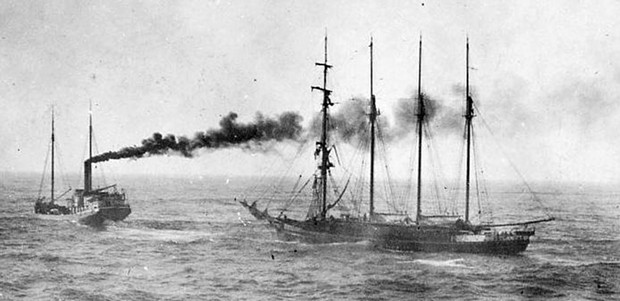
Photo courtesy of the Kelly House Museum
A happier day for the Brooklyn, here towing a four-masted barkentine from Big River.
[
{
"name": "Top Stories Video Pair",
"insertPoint": "7",
"component": "17087298",
"parentWrapperClass": "fdn-ads-inline-content-block",
"requiredCountToDisplay": "1"
}
]
"We live hard, we die hard, and we go to hell!"
— Jorgen Greve, sole survivor of the Brooklyn wreck, two years later, in conversation with maritime historian Wallace Martin
"It looks as though we can make it." By his own admission, First Officer Jorgen Greve encouraged Capt. F. J. Tufvessen to hold course as the Brooklyn steamed out of Humboldt Bay into the Pacific on an ebb tide. That afternoon, Nov. 8, 1930, there was nothing pacific about the ocean. The 137-foot steam schooner, built at Lindstrom shipyard in Grays Harbor, Oregon, in 1901, had survived much worse in her 28 years of service.
Here's how Greve remembered the event a few days later from his bed in St. Joseph Hospital:
Coming through the bar Saturday, the water was rough ... but fairly smooth straight ahead. We decided to make it across when two tremendous comers hit the ship's bow, one after the other. When the third comer struck, the engineer came out on deck and said, "We are all done." The engine room had flooded and the fires extinguished. After that we couldn't steer anymore. [The skipper of a fishing boat outside the bar later said that he saw steam — not smoke — coming from the Brooklyn's stack, indicating that the engine room was flooded.] Seas broke over her and tore off the port lifeboat .... The ship was keeling more and more. The top of the pilot house was knocked off by a big wave ... she sank further and further. The next wave that struck, she came keel up.
Wrecks sometimes occur when ships are overloaded, but in this case, the opposite happened. The Brooklyn's cargo — milled wood being shipped from Humboldt Bay to San Francisco — usually consisted of 80,000 board-feet of lumber below decks and 200,000 on decks. That Saturday, however, the Brooklyn sailed with less than 30,000 board feet, all below. Without the usual deck lumber to protect doors and windows, the heavy waves flooded into the body of the ship, including the engine room.
Along with several other crewmen, Greve was thrown into the water, beginning a three-day ordeal. "I swam as hard as I could to get clear of the wreckage, while being hit by bits of wreckage, swimming from one piece of wreckage to another until I found a piece of bulkhead," he said. "I tried to keep away from land, fearing the heavy breakers near the shore."
Clinging to the bulkhead, Greve drifted up to Trinidad Head, 20 miles north of the bay entrance. "I paddled with all my strength with pieces of a board to make land, but the current stopped me. After that, I do not remember much. I didn't see any of the other men."
The wreck happened on Saturday. The following Tuesday — 70 hours later — the Two Sisters fishing boat was about 5 miles from the entrance to Humboldt Bay, heading north, when its crew saw "what looked like a man on part of a floating bit of wreckage." They took the semi-conscious Greve to the Eureka docks, where an ambulance was waiting. However, his travails weren't over: A car hit the speeding ambulance at Wabash and F streets, and he had to be carried on a stretcher to St. Joseph Hospital.
The fact that 18 men drowned while Greve alone survived might strike sailors (who have a reputation for superstition) as pre-ordained, since this was the fourth time he had been rescued; in the previous 20 years, he'd survived three other shipwrecks. After the Brooklyn wreck, he was promoted to captain and lived for another 10 years, until he lost his final battle against cancer.
The Brooklyn was far from the only ship to be wrecked while trying to cross the Humboldt Bay bar, starting with the tug Merrimac in 1863 (18 lives lost), with numerous other recorded disasters. But the drama of the Brooklyn stands out, with its story of one crewman, against all odds, managing to survive in the icy Pacific.
Barry Evans (he/him, [email protected]) knows it's sexist to feminize marine vessels, but he's quoting the survivor, so his ever-gracious editor will allow it. This once.
more from the author
-
Doubting Shakespeare, Part 3: Whodunnit?
- May 9, 2024
-
Doubting Shakespeare, Part 2: Problems
- May 2, 2024
-
Doubting Shakespeare, Part 1: Stratfordians vs. anti-Stratfordians
- Apr 25, 2024
- More »
Latest in Field Notes
Readers also liked…
-
Trouble on the Line: The Reality Part 2
- Nov 3, 2022
































